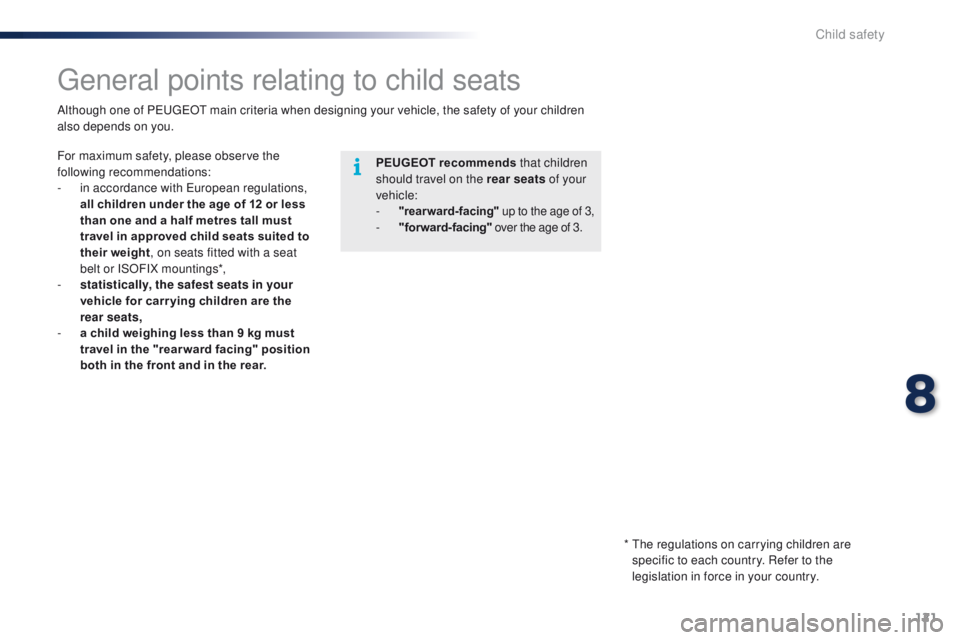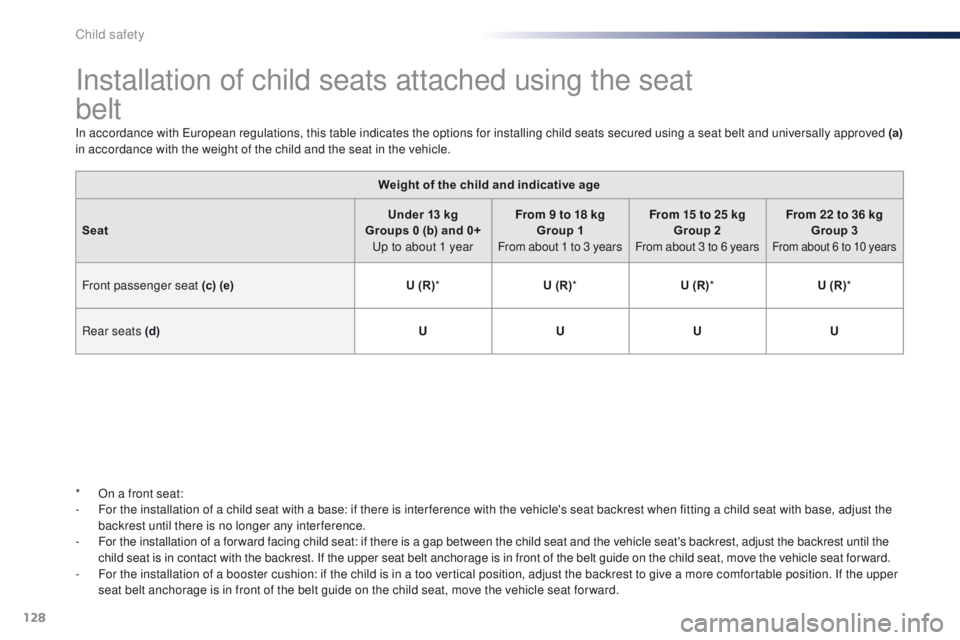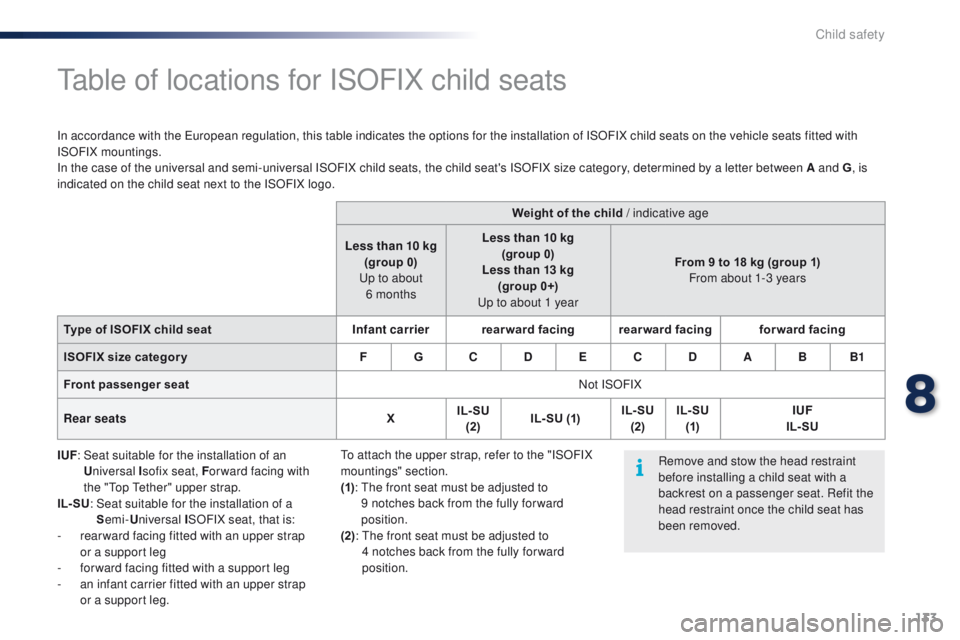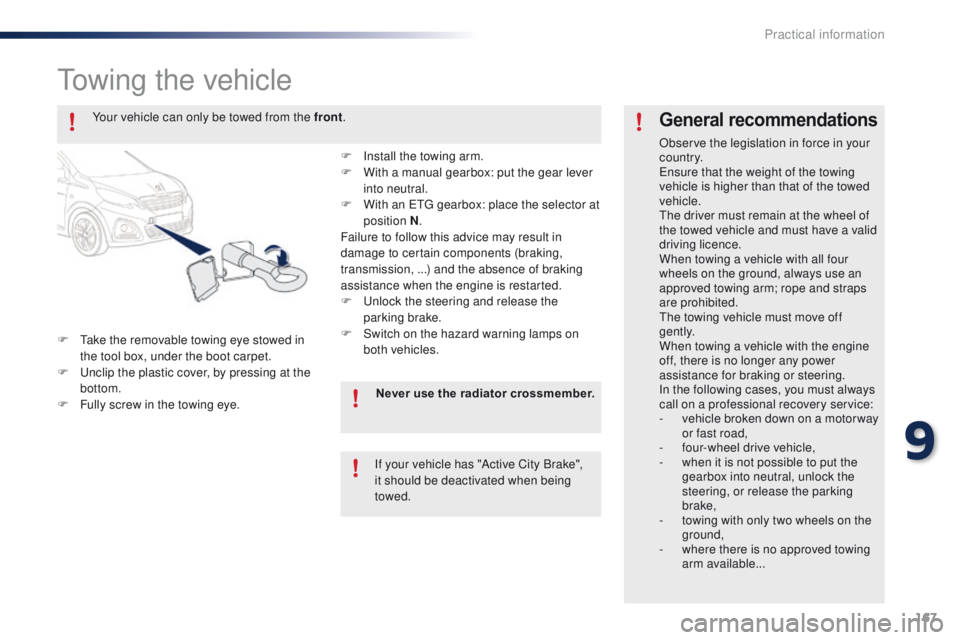Page 5 of 271
.
.
108_en_Chap00a_sommaire_ed01-2015
Direction indicators 101
Horn
10
1
Hazard warning lamps
1
02
Under-inflation detection
1
02
e
SC system
1
05
Active City Brake
1
08
Seat belts
1
13
Airbags
116
Safety
Child seats 1 21
Deactivating the passenger's front airbag
1
24
ISOFIX child seats
1
30
Child lock
1
35
Child safety Checks
Fuel tank 1
36
te
mporary puncture repair kit
1
38
Changing a wheel
1
43
Snow chains
1
48
Changing a bulb
1
49
Changing a fuse
1
54
12 V battery
1
63
el
ectrical energy economy mode
1
66
Changing a wiper blade
1
66
to
wing the vehicle
1
67
Fitting roof bars
1
68
Accessories
169
Practical informationte chnical data
7-inch touch screen 183
Radio 223
Audio equipment and telematics
Visual search
Alphabetical index
B o n n et 17 2
Petrol engines
1
73
Checking levels
1
74
C h e c ks
17 7
en
gines
1
79
Weights
180
Dimensions
1
81
Identification markings
1
82
Contents
Page 47 of 271
45
108_en_Chap03_confort_ed01-2015
Front seats with manual adjustments
F Raise the control and slide the seat forwards or backwards. F
P ull the control upwards to raise or push
it downwards to lower, as many times as
required, to obtain the position required.
F
ta ke the weight of the backrest with your
b o dy.
F
t
u
rn the knob to obtain the desired angle.
Forwards-backwards Driver's seat height*
Seat backrest angle
As a safety measure, seat adjustments should only be carried out when stationary.
Before moving the seat backwards, ensure that there is nothing that might prevent the full
travel of the seat, so as to avoid the risk of of jamming the seat caused by the presence of
objects on the floor behind the seat or rear passengers. If the seat jams, stop the movement
immediately. * Depending on version.
3
Comfort
Page 123 of 271

121
108_en_Chap08_securite-enfants_ed01-2015
general points relating to child seats
PEUGEOT recommends that children
should travel on the rear seats of your
vehicle:
-
"rearward-facing" up to the age of 3,- "forward-facing" over the age of 3.
Although one of P
e
uge
Ot
main criteria when designing your vehicle, the safety of your children
also depends on you.
For maximum safety, please observe the
following recommendations:
-
i
n accordance with
e
u
ropean regulations,
all children under the age of 12 or less
than one and a half metres tall must
travel in approved child seats suited to
their weight , on seats fitted with a seat
belt or ISOFIX mountings*,
-
s
tatistically, the safest seats in your
vehicle for carr ying children are the
rear seats,
-
a c
hild weighing less than 9 kg must
travel in the "rear ward facing" position
both in the front and in the rear.
*
t
h
e regulations on carrying children are
specific to each country. Refer to the
legislation in force in your country.
8
Child safety
Page 130 of 271

128
108_en_Chap08_securite-enfants_ed01-2015
Installation of child seats attached using the seat
belt
In accordance with european regulations, this table indicates the options for installing child seats secured using a seat belt and universally approved (a)
in accordance with the weight of the child and the seat in the vehicle.
Weight of the child and indicative age
Seat Under 13 kg
Groups 0 (b) and 0+
up t
o about 1 yearFrom 9 to 18 kg
Group 1
From about 1 to 3 years From 15 to 25 kg
Group 2
From about 3 to 6 years From 22 to 36 kg
Group 3
From about 6 to 10 years
Front passenger seat (c) (e) U (R)* U (R)* U (R)* U (R)*
Rear seats (d) UUUU
*
O
n a front seat:
-
F
or the installation of a child seat with a base: if there is inter ference with the vehicle's seat backrest when fitting a child seat with base, adjust the
backrest until there is no longer any interference.
-
F
or the installation of a for ward facing child seat: if there is a gap between the child seat and the vehicle seat's backrest, adjust the backrest until the
child seat is in contact with the backrest. If the upper seat belt anchorage is in front of the belt guide on the child seat, move the vehicle seat for ward.
-
F
or the installation of a booster cushion: if the child is in a too vertical position, adjust the backrest to give a more comfortable position. If the upper
seat belt anchorage is in front of the belt guide on the child seat, move the vehicle seat for ward.
Child safety
Page 135 of 271

133
108_en_Chap08_securite-enfants_ed01-2015
table of locations for ISOFIX child seats
In accordance with the european regulation, this table indicates the options for the installation of ISOFIX child seats on the vehicle seats fitted with
ISOFIX mountings.
In the case of the universal and semi-universal ISOFIX child seats, the child seat's ISOFIX size category, determined by a letter between A and G , is
indicated on the child seat next to the ISOFIX logo.
IUF :
S
eat suitable for the installation of an
U niversal I sofix seat, F or ward facing with
the "
to
p t
e
ther" upper strap.
IL- SU :
S
eat suitable for the installation of a
S emi- Universal I SOFIX seat, that is:
-
r
ear ward facing fitted with an upper strap
or a support leg
-
f
or ward facing fitted with a support leg
-
a
n infant carrier fitted with an upper strap
or a support leg. Weight of the child / indicative age
Less than 10 kg (group 0)
up t
o about
6
monthsLess than 10 kg
(group 0)
Less than 13 kg (group 0+)
up t
o about 1 yearFrom 9 to 18 kg (group 1)
From about 1-3 years
Type of ISOFIX child seat Infant carrierrearward facing rearward facing forward facing
ISOFIX size categor y FG C D E C D ABB1
Front passenger seat Not ISOFIX
Rear seats XIL- SU
(2) IL- SU (1) IL- SU
(2) IL- SU
(1) IUF
IL- SU
Remove and stow the head restraint
before installing a child seat with a
backrest on a passenger seat. Refit the
head restraint once the child seat has
been removed.
to a
ttach the upper strap, refer to the "ISOFIX
mountings" section.
(1) :
t
h
e front seat must be adjusted to
9
notches back from the fully for ward
position.
(2):
t
h
e front seat must be adjusted to
4
notches back from the fully for ward
position.
8
Child safety
Page 169 of 271

167
108_en_Chap09_info-pratiques_ed01-2015
towing the vehicle
F take the removable towing eye stowed in the tool box, under the boot carpet.
F
u
n
clip the plastic cover, by pressing at the
bottom.
F
F
ully screw in the towing eye.
General recommendations
Observe the legislation in force in your
c o unt r y.
en
sure that the weight of the towing
vehicle is higher than that of the towed
vehicle.
th
e driver must remain at the wheel of
the towed vehicle and must have a valid
driving licence.
When towing a vehicle with all four
wheels on the ground, always use an
approved towing arm; rope and straps
are prohibited.
th
e towing vehicle must move off
g e nt l y.
When towing a vehicle with the engine
off, there is no longer any power
assistance for braking or steering.
In the following cases, you must always
call on a professional recovery service:
-
v
ehicle broken down on a motor way
or fast road,
-
f
our-wheel drive vehicle,
-
w
hen it is not possible to put the
gearbox into neutral, unlock the
steering, or release the parking
brake,
-
t
owing with only two wheels on the
ground,
-
w
here there is no approved towing
arm available...
Your vehicle can only be towed from the front
.
F
I
nstall the towing arm.
F
W
ith a manual gearbox: put the gear lever
into neutral.
F
W
ith an
etg
gearbox: place the selector at
position N .
Failure to follow this advice may result in
damage to certain components (braking,
transmission, ...) and the absence of braking
assistance when the engine is restarted.
F
u
n
lock the steering and release the
parking brake.
F
S
witch on the hazard warning lamps on
both vehicles.
Never use the radiator crossmember.
If your vehicle has "Active City Brake",
it should be deactivated when being
towed.
9
Practical information
Page 170 of 271
168
108_en_Chap09_info-pratiques_ed01-2015
Fitting roof bars
When fitting transverse roof bars, use the
accessories recommended by PeugeOt and
follow the manufacturer's fitting instructions.
For more information, contact a P
e
uge
Ot
dealer or a qualified workshop. Please refer to national legislation in
order to comply with the regulations
concerning the transportation of objects
which are longer than the vehicle.
Maximum weight authorised on the bars,
for a loading height not exceeding 40 cm
(except bicycle carrier): 40 kg.
If the height exceeds 40 cm, adapt the
speed of the vehicle to the profile of the
road to avoid damaging the roof bars.
Practical information
Page 182 of 271
180
108_en_Chap11_caracteristiques-techniques_ed01-2015
EngineVTi 68VTi 68 S&SPureTech 82
Gearbox Manual
(5 - speed) ETG electronic
(5 - speed) Manual
(5 - speed) Manual
(5 - speed)
Model code:
P... SCFBB
SCFBC ...B1A
...H1A ...P1A
...W1A SCFBB
SCFBC ...B1C
...H1C ...P1C
...W1C SCFB2
SCFB3 ...B1B
...H1B ...P1B
...W1B AHMTB
AHMTC ...B1A
...H1A ...P1A
...W1A
Kerb weight 840860 855865
un
laden weiight* 915935 930940
gr
oss vehicle weight
(
g
V
W) 1 240
1 2401 2401 240
gr
oss train weight (
g
t
W
) 1 2401 2401 2401 240
Weights (in kg)
the design of your vehicle does not permit the fitting of a towbar.
*
t
h
e unladen weight is equal to the kerb weight + driver (75 kg).
...B1
: 3 -door version.
...H1 : 5 -door version. ...P1
: 3 -door convertible version.
...W1 : 5 -door convertible version.
technical data